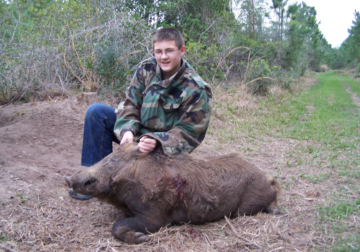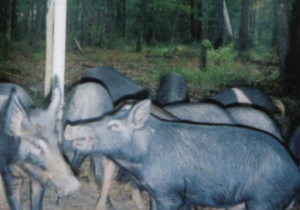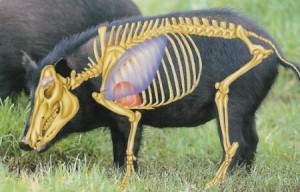Sus Scrofa "Wild Boar"
Other Common names: Russian Boar, Pineywood Rooter, Razorback, Eurpean Boar, Eurasian Boar, and Feral Hog.
Wild boar are abundant in the United States and around the world. This resilient animal will flourish in almost any habitat. Wild Boar in the United States are a mixture of European and Feral. European boar differ in Feral hogs in that a Feral hog is no more than a domestic pig that has either escaped or was introduced into the wild. European boar were introduced to the United States for a multitude of reasons. Feral "wild" boar and European boar will readily cross breed. The features of the European boar will usually dominate after cross breeding, but the blood line will rapidly diminish since the breeding cycles are often and generations are so close together. Our friends from the Tuscany Boar Hunting Club in Italy show some great examples of European Boar.



Domestic pigs introduced into the wild will also change features with each generation to meet the demands of nature and survival, as seen above.
Basic features of european and feral hogs include the following: Thick hair with a mane that runs down the back, sometimes called a "Mohawk." Hairy ears and a strait tail that is tufted with long hair on the end, not curled like domestic pigs. Tusks can grow longer than four inches. Pure european colors range from gray/black to red/brown; cross breed's can be spotted, striped, brindle, or calico in a variety of colors. Most piglets are born with chipmunk colors, light brown with brown and black stripes that disappear by four months of age although feral's will very.
Herds usually consist of two or three sows, piglets and sometimes younger boar. Older boar will be seen with the herds when the sow are in heat. The older the wild boar is, the more likely they will not be seen in groups. Dominant wild boar are loaners and prefer to keep to themselves most of the time, if a good food source is involved, their is no telling how many herds will be involved. Sows will usually have one or two litters per year. litters can be as high as 10. Survival rate is much lower and depends on several circumstances, to include: region, health, food sources, amount of predators, etc. average survival is about 4-6 piglets living past 12 mos of age. Sow from the same herd usually share nursing responsibility, and give birth in relatively the same time frame. It is almost impossible to distinguish which sow is the mother of each liter.
Wild boar can cause some major destruction world wide, from soil erosion to crop damage. Love or hate them; they have flourished, and they are coming to your neighborhood very soon!
As you can see in the above picture you want to place your shot in the shoulder area aiming just below the shoulder. If the hog is going away from you or towards you, you want the shot placed between the shoulders. Either of these shots will result in hitting vital organs.

